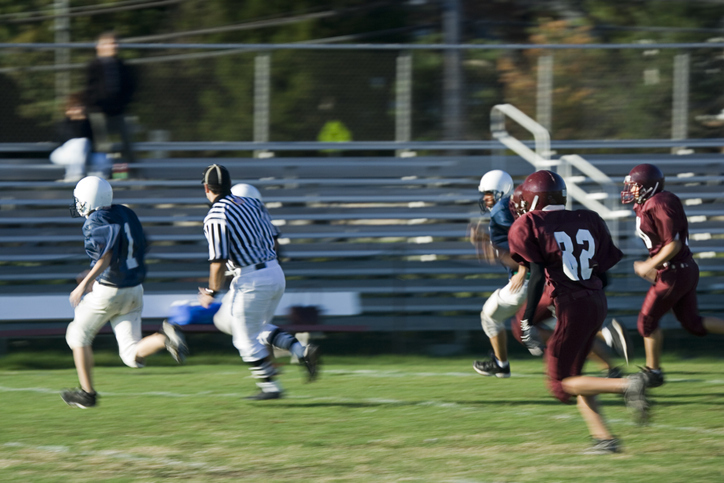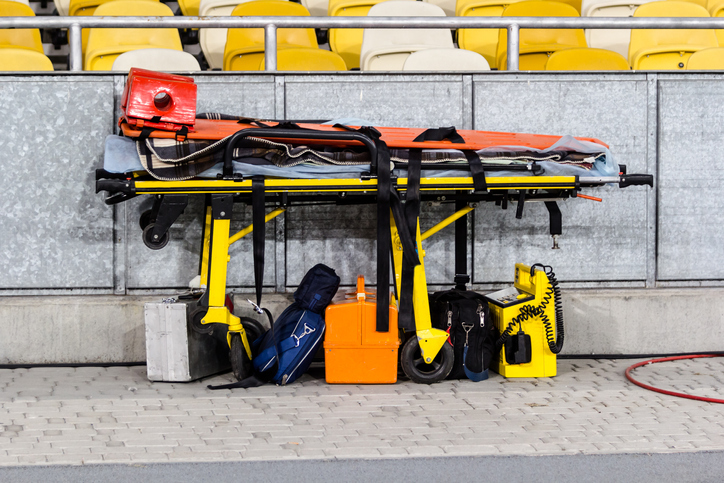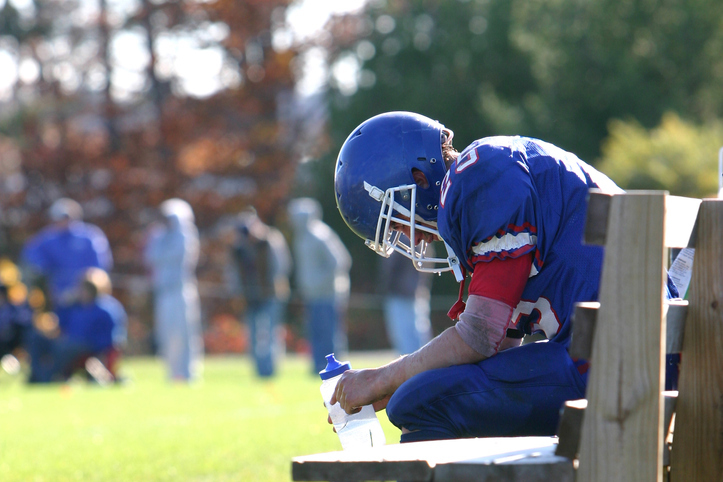Introduction
Sports medicine physicians cover an array of athletic events, but at the youth and high school level, football most often mandates a physician sideline presence. While advances in technology and rule changes have made the game safer over the years, injury rates in football are the highest among all high school sports.1 There were an estimated 455,449 football injuries in high school athletes during the year 2018-2019 and while the majority of these were minor injuries, catastrophic injuries do occur.1 The National Center for Catastrophic Sport Injury Research reported 20 fatalities among football players of all levels of play during 2021.2 Preparing and implementing an emergency action plan is key to responding to these events. The purpose of this review is to provide information for team physicians, athletic trainers and other allied health professionals to diagnose and treat the most common sideline emergencies.
Cardiac

Sudden cardiac arrest (SCA) is the leading cause of death for student athletes. As many as 23,000 people under the age of 18 experience SCA and sports-related SCA accounts for nearly 40% of these events.3 In younger athletes, the most common causes of SCA include genetic or congenital cardiovascular abnormalities and in North America, the most common cause of SCA is hypertrophic cardiomyopathy.4 Other important causes include myocarditis and commotio cordis, caused by blunt non-penetrating trauma to the precordial area which may provoke spontaneous ventricular fibrillation. Regardless of the cause, presentation and initial management will be the same.
Any athlete that has collapsed or is unresponsive should be assumed to be in cardiac arrest. Evaluation should include airway, breathing and circulation (ABCs). In an unresponsive athlete, emergency response services should be called immediately by a bystander. Ask that person or another bystander to bring an AED. Next, pulses should be assessed. If none are felt, chest compressions should begin. An AED should be applied as soon as possible.
The NFL, in partnership with several other professional sports leagues and organizations including AOSSM, launched the Smart Heart Sports Coalition in 2023 in response to the life-saving emergency care provided to Damar Hamlin following his football-related SCA. The coalition is advocating for all 50 states to adopt evidence-based policies that will prevent fatal outcomes from SCA among high school students. These three best practice policies include:3
- Emergency action plans (EAPs) for each high school athletic venue that are widely distributed, posted, rehearsed and updated annually.
- Clearly marked automated external defibrillator (AEDs) at each athletic venue or within 1-3 minutes of each venue where a high school’s practices or competitions are held.
- Cardiopulmonary resuscitation (CPR) and AED education for coaches.
Appropriately trained personnel on the sideline are essential in recognizing and treating these emergencies. The American Heart Association has recognized six key components in the adult out-of-hospital chain of survival which include recognition of cardiac arrest and activation of the emergency response team, early CPR with an emphasis on chest compressions, rapid defibrillation, advanced resuscitation by emergency medical services or other healthcare professionals, post-cardiac arrest care, and recovery.5 Access to AEDs is crucial for survival. A 2-year prospective study looking at outcomes from sudden cardiac death in US high schools using the national registry for AED use in sports found that 89% of student-athletes who arrested during physical activity survived to hospital discharge.6
Concussion/Head Injury
The most common injury sustained by high school football players is concussion at a rate of 22% and head injuries are the leading cause of traumatic death in sports overall.1 There were four traumatic injury fatalities that occurred among football players during 2021 and all were related to traumatic brain injuries.2 Sport-related concussion is a traumatic brain injury caused by a direct blow to the head, neck or body resulting in an impulsive force being transmitted to the brain that occurs in sports and exercise-related activities. This initiates a neurotransmitter and metabolic cascade, with possible axonal injury, blood flow change and inflammation affecting the brain. Symptoms and signs may present immediately, or evolve over minutes or hours, and commonly resolve within days, but may be prolonged (7). Headache is the most common symptom, with other symptoms including loss of consciousness, amnesia, blurred vision, imbalance, dizziness and nausea.8
If a head or neck injury is suspected, evaluation should begin with the ABCs. Next, the cervical spine should be assessed. Once the cervical spine is cleared, a thorough neurological exam should be completed. If there are any focal neurological deficits, the athlete should be transferred to the emergency department. If there are no focal neurological deficits but the athlete is experiencing signs and symptoms of a concussion, they should be removed from competition and not allowed to return to play that day. Sideline assessment tools such as the standardized assessment of concussion and SCAT6 can be administered. The athlete should be observed closely for any changes in status. The standard of care calls for follow-up assessments every 20 to 30 minutes for the first hour and then once over the next hour. These assessments are important to ensure a more serious injury is not developing such as a subdural or subarachnoid hemorrhage.9
Spinal Cord Injury

Spinal cord injuries have lifelong impact on health and quality of life. In American football, 96% of spinal cord injuries occur at the cervical spine level.10 These injuries have a wide spectrum of severity including stingers/burners, cervical cord neuropraxia, and catastrophic neurological injury.11 Cervical cord neuropraxia and catastrophic neurological injury occurs at a rate of 0.2 per 100,000 and 0.5 per 100,000 participants in high school football, respectively.11
Differentiating between stingers/burners and more serious spinal cord injuries can be difficult. Stingers are traumatic stretch injuries of one or more cervical nerve roots or the brachial plexus causing a transient neuropraxia.12 These injuries are typically unilateral in nature and last minutes to hours. More serious spinal cord injuries are associated with red flag symptoms such as bilateral symptoms, decreased consciousness or unconsciousness, focal tenderness over the cervical spine, paralysis, restricted cervical range of motion, or severe neck pain.12
Assume unconscious athletes have a cervical spine injury and address the ABCs. Athletes with a suspected spinal cord injury should be placed onto a spine board with minimal manipulation while maintaining in-line cervical axial stabilization. Common methods for transfer to the spinal board include log roll or lift and slide maneuver. The helmet and shoulder pads should be left in place and the facemask should be removed for airway access. If the helmet is removed, the shoulder pads should also be removed to prevent cervical spine hyperextension. Conversely, if the shoulder pads are removed, the helmet should also be removed to prevent cervical spine hyperflexion. Once stabilized, the athlete should be assessed for midline cervical tenderness and evaluated for neurological deficits. If there are any concerning findings on examination, transport to the nearest emergency department is recommended.
Respiratory Emergencies
Sideline respiratory emergencies include asthma, pneumothorax, and exercise-induced anaphylaxis. Asthma is one of the most common respiratory conditions with a high prevalence in teenagers and adolescents. Athletes appear to have a higher prevalence of asthma when compared to the general population.13 Asthma should be considered when an athlete reports symptoms including wheezing, cough, chest tightness or pain, dizziness, fatigue, or unexpected shortness of breath during or following exercise.14 The first step in evaluation of an individual with airway hyper-reactivity is to remove from play and test peak expiratory flow rate. This should be compared to the player's baseline. If PEF is 10-15% below baseline, administer two puffs of short-acting beta 2-agonist via MDI with a spacer. Repeat PEF at five minutes and if returned to baseline, the athlete may return to play. If not, administer a second dose of two puffs of a short-acting beta 2-agonist. Repeat PEF at five minutes. If normalized, the athlete may return to play. If not, consider referral to the emergency department.14
Another less common respiratory emergency that may be encountered during sport is a tension pneumothorax. This is caused by the continuous entrance and entrapment of air into the pleural space which can cause compression of the lungs and major blood vessels in the thoracic cavity. Ultimately, this can impair cardiac output and result in death. Immediate decompression may be lifesaving. Symptoms include severe shortness of breath, shallow breathing and acute chest pain. There will be decreased or absent breath sounds on auscultation. The tenth edition of the Advanced Trauma Life Support recommends needle thoracostomy to be performed in the fourth or fifth intercostal space of the mid-axillary line.
Exercise-induced anaphylaxis is a rare but potentially life-threatening syndrome. Symptoms are usually triggered by exercise of moderate intensity. The usual sequence of symptomatology includes prodromal, early, and fully established manifestations. Premonitory symptoms include fatigue, warmth, itching and cutaneous erythema. Early symptoms then include urticarial eruption and possible angioedema. Loss of consciousness can also occur during this period. Choking, respiratory stridor and gastrointestinal symptoms are noted with fully developed attacks.15 Acute treatment is similar to that of other types of anaphylaxis including epinephrine, antihistamines and systemic corticosteroids.16
Heat Illness

Heat-related illness is a physiologic insult that occurs when the body is unable to dissipate heat adequately, which leads to dysfunctional thermoregulation.17 There is a spectrum of heat-related illness from mild conditions such as heat edema or exercise-associated muscle cramps to potentially fatal conditions such as heat stroke. Two deaths from exertional heat stroke in high school athletes occurred in 2021.2 Risk factors include strenuous exercise, exposure to high temperatures and/or humidity, lack of acclimation, poor physical fitness, and excessive clothing, equipment or protective gear, many of which can apply to football practices and games.
Symptoms can be nonspecific and a high degree of suspicion is required. Symptoms include lightheadedness, muscle cramps, fatigue, weakness, nausea and vomiting, altered mental status and seizures. The first step after suspected heat related illness is to obtain a temperature. Rectal temperature is considered the gold standard for measurement of core body temperature.
Mild illness such as heat edema or exercise associated muscle cramps require supportive care. Heat exhaustion which is characterized by cardiovascular hypoperfusion and rectal core temperature of up to 104 degrees without central nervous system (CNS) dysfunction and requires mild cooling, rest and hydration. Heat stroke is a medical emergency in which patients often display altered mental status and have a rectal core temperature of 105 degrees or greater, multi organ damage or CNS dysfunction. Treatment includes immediate ice water or cold-water immersion.17
Emergency Action Plan/Preparedness
For all the above scenarios, the best treatment begins with a proper emergency action plan (EAP). An EAP is a written, step-by-step document outlining the care of injured athletes. It should include the personnel involved and their roles in the response; available emergency equipment; and venue-specific information. It should also include athlete transport procedures from the facility or field to the hospital. Examples of roles required in response to an emergency include:18
- Who contacts emergency medical services?
- Who has the keys to unlock gates or doors and who will complete this task?
- Who will identify the specific training of each responder?
- Who is responsible for checking the availability and current certification of emergency equipment?
- Who will accompany the student to the hospital when parents are not available?
- Who will contact the parent? Where is this contact information found?
The emergency response team consists of, at a minimum, the team’s certified athletic trainer and local emergency medical services. Other possible members include team physicians, allied health professionals, coaches and school administrators. Each person should have a clearly defined role in the event of a sideline emergency.
Equipment to include: AED, bag valve mask, pocket mask for CPR, spine board, cervical collars, rectal thermometer, facemask removal equipment, PPE, oropharyngeal and nasopharyngeal airways, stethoscope and sphygmomanometer, cold water immersion tub, 14-gauge needle for needle thoracostomy and EPIPEN.® The location of this equipment should be made known to the members of the EAP team as well as the visiting team. A medical timeout prior to the start of an athletic event to discuss EAPs with medical staff, officials, coaches and administrators is also always recommended.
Conclusion
In conclusion, preparation is the key to preventing and responding to sideline emergencies. It begins long before the athlete steps onto the field with the development and rehearsal of an emergency action plan. Other preparation components include functioning and accessible emergency equipment, CPR/AED instruction for all members of the emergency response team and pre-participation physical exams for athletes. When emergencies do occur, coordination between athletic trainers, team physicians, coaches and administrators to implement the emergency action plan can be lifesaving.
References
1. Comstcock RD, Pierpoint LA. National High School Sports-Related Injury Surveillance Study 2018-2019 School Year. https://coloradosph.cuanschutz.edu/docs/librariesprovider204/default-document-library/2018-19.pdf?sfvrsn=d26400b9_2
2. Kucera KL, Klossner D, Colgate B, Cantu RC. Annual Survey of Football Related Research 1931-2021. https://nccsir.unc.edu/wp-content/uploads/sites/5614/2022/05/Annual-Football-2021-Fatalities-FINAL-public-1.pdf
3. NFL Founds Coalition to Advance Adoption of Life-Saving Policies For Student Athletes. nfl.com. https://www.nfl.com/playerhealthandsafety/resources/press-releases/nfl-founds-coalition-to-advance-adoption-of-life-saving-policies-for-student-ath
4. Schmied C, Borjesson M. Sudden cardiac death in athletes. J Intern Med. 2014 Feb;275(2):93-103. doi: 10.1111/joim.12184. PMID: 24350833.
5. American Heart Association. Out-of-hospital chain of survival. https://cpr.heart.org/en/resources/cpr-facts-and-stats/out-of-hospital-chain-of-survival
6. Drezner JA, Toresdahl BG, Rao AL, Huszti E, Harmon KG. Outcomes from sudden cardiac arrest in US high schools: a 2-year prospective study from the National Registry for AED Use in Sports. Br J Sports Med. 2013 Dec;47(18):1179-83. doi: 10.1136/bjsports-2013-092786. Epub 2013 Oct 11. PMID: 24124037.
7. Patricios JS, Schneider KJ, Dvorak J, Ahmed OH, Blauwet C, Cantu RC, Davis GA, Echemendia RJ, Makdissi M, McNamee M, Broglio S, Emery CA, Feddermann-Demont N, Fuller GW, Giza CC, Guskiewicz KM, Hainline B, Iverson GL, Kutcher JS, Leddy JJ, Maddocks D, Manley G, McCrea M, Purcell LK, Putukian M, Sato H, Tuominen MP, Turner M, Yeates KO, Herring SA, Meeuwisse W. Consensus statement on concussion in sport: the 6th International Conference on Concussion in Sport-Amsterdam, October 2022. Br J Sports Med. 2023 Jun;57(11):695-711. doi: 10.1136/bjsports-2023-106898. PMID: 37316210.
8. Scorza KA, Cole W. Current Concepts in Concussion: Initial Evaluation and Management. Am Fam Physician. 2019 Apr 1;99(7):426-434. PMID: 30932451.
9. Podell K, Presley C, Derman H. Sideline Sports Concussion Assessment. Neurol Clin. 2017 Aug;35(3):435-450. doi: 10.1016/j.ncl.2017.03.003. PMID: 28673408.
10. Chan CW, Eng JJ, Tator CH, Krassioukov A; Spinal Cord Injury Research Evidence Team. Epidemiology of sport-related spinal cord injuries: A systematic review. J Spinal Cord Med. 2016 May;39(3):255-64. doi: 10.1080/10790268.2016.1138601. Epub 2016 Feb 18. PMID: 26864974; PMCID: PMC5073752.
11. Rihn JA, Anderson DT, Lamb K, Deluca PF, Bata A, Marchetto PA, Neves N, Vaccaro AR. Cervical spine injuries in American football. Sports Med. 2009;39(9):697-708. doi: 10.2165/11315190-000000000-00000. PMID: 19691361.
12. Usman S. Management of Head and Neck Injuries by the Sideline Physician. Am Fam Physician. 2022 Nov;106(5):543-548. PMID: 36379500.
13. Thomas S, Wolfarth B, Wittmer C, Nowak D, Radon K; GA2LEN-Olympic study-Team. Self-reported asthma and allergies in top athletes compared to the general population - results of the German part of the GA2LEN-Olympic study 2008. Allergy Asthma Clin Immunol. 2010 Nov 30;6(1):31. doi: 10.1186/1710-1492-6-31. PMID: 21118543; PMCID: PMC3004879.
14. Allen TW. Sideline management of asthma. Curr Sports Med Rep. 2005 Dec;4(6):301-4. doi: 10.1097/01.csmr.0000306290.75256.95. PMID: 16282030.
15. Sheffer AL, Austen KF. Exercise-induced anaphylaxis. J Allergy Clin Immunol. 1980 Aug;66(2):106-11. doi: 10.1016/0091-6749(80)90056-1. PMID: 7400473.
16. Barg W, Medrala W, Wolanczyk-Medrala A. Exercise-induced anaphylaxis: an update on diagnosis and treatment. Curr Allergy Asthma Rep. 2011 Feb;11(1):45-51. doi: 10.1007/s11882-010-0150-y. PMID: 20922508; PMCID: PMC3020292.
17. Gauer R, Meyers BK. Heat-Related Illnesses. Am Fam Physician. 2019 Apr 15;99(8):482-489. PMID: 30990296.
18. Young L, D’Anza M. Emergency Action Plans: Practice Makes Perfect. nfhs.org, 20 Dec. 2021, https://www.nfhs.org/articles/emergency-action-plans-practice-makes-perfect/

